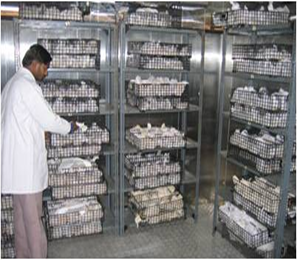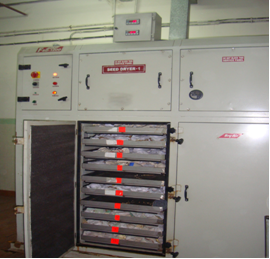Sample processing of radish genetic resources
Contributors to this page: CAAS, China (Qiu Yang, Li Xixiang); Bioversity International, Italy (Imke Thormann, Ehsan Dulloo); CGN, Netherlands (Noortje Bas); IPK, Germany (Andreas Börner, Ulrike Lohwasser); AVRDC, Taiwan (Andreas Ebert); USDA, USA (Larry Robertson); NBPGR, India (Chitra Pandey); SASA, UK (George Campbell); University of Warwick, UK (Charlotte Allender).
|
Contents: |
Seed cleaning is required to remove non-seed material and unhealthy and undersized seeds after harvesting, before storage, in order to preserve high quality samples.
- The radish siliques need to be dried in the sun or in a drying cabinet and are then broken up by beating or threshing to release the seed.
- Wild radish siliques are difficult to thresh. When siliques cannot be removed, the seeds are conserved in the siliques and the siliques are broken into single pieces.
- Remove all debris, separate empty seeds, seeds of other species and other light material with sieves, a seed cleaner or by blowing, winnowing or hand cleaning.
- Check the labels of the seed inside and outside of the seed bag or the seed envelope, to ensure correct identity.
Visual inspection of seeds
This is a quality control measure that must be done after harvesting the seeds to examine seeds for damage.
- Spread the seeds on a flat and well lit surface of contrasting color.
- An illuminated table can be used if available.
-
Observe for and manually discard
- Germinated seeds
- Physically damaged or empty seeds
- Moldy seeds
- Seeds without testa
- Seeds smaller than one-half of the original size
Verification
- Check the sample again visually for purity and damaged seeds.
- Check the reference sample or reference data for matching seed color and shape.
- Carefully destroy the waste material to prevent the spread of insects and diseases to other material.
Recording information during seed cleaning
Record the seed-cleaning procedures using the following descriptors:
- Type of sample
- Method of extraction, threshing and cleaning
- Date of cleaning
- Total seed number or weight after cleaning
|
|
Methods
- Use a dehumidified drying room to dry the cleaned seeds under controlled relative humidity and temperature.
- All seed samples are dried to equilibrium in a controlled environment of 5-20 °C and 10-25 % RH.
-
Examples of drying conditions used in genebanks:
- AVRDC: 15% RH and 20 ºC for at least 4 weeks.
- CAAS: 13-30% RH and 15-25 ºC.
- CGN: 15% RH and 15ºC for at least 6 weeks.
- IPK: 10% RH and 18 ºC, 2-3 weeks.
- NGB-NBPGR: 15%RH and 15ºC for up to four weeks. Seeds received with high moisture content are pre-dried in a warm dry place before transferring into walk-in seed drying rooms or seed drying cabinets.
- SASA: 15%RH and 15ºC for up to four weeks.
- USDA: 20% RH and 5oC; drying for 2 months.
- The seed samples should be kept in a paper, mesh or cotton bag on mesh racks during the drying period.
Drying time
- Depending on the initial seed moisture content and seed size, minimum is 2-4 weeks.
- The lower the relative humidity the faster the seed drying rate.
- One possible procedure is to accompany each batch of seed samples with ‘date in’ and ‘date to seal and store’ information.
Moisture content before drying
- 10-12% is a typical starting moisture content in dry areas. In other areas the range will be different (higher).
Moisture content for storage
- 3-5% for long term storage, 5-7% for active collection.
Recording information during seed drying
The following information should be recorded for each processing step:
- Accession number (an ID number).
- Lot number (an ID number).
- Seed weight (weight of seeds for storage).
- Reference to seed source (to trace the origin of the sample).
- Remarks.
Determination of seed moisture content
Methods
- Use a low constant temperature oven-drying according to the ISTA 2005 methods.
- Electronic bowl or probe method suitable for a fairly accurate reading of moisture content without seed loss.
Sampling frequency
- Random but the sample should be representative of the entire accession.
Sample size
- Use two independent replicates of 0.5-1.0 g of seeds.
- A minimum of ten seeds.
Oven drying temperature
- 103±2ºC for 17±1 hour.
Recording information during seed moisture content
The following information should be recorded for each step:
- Accession Number.
- Net fresh weight in grams (g).
- Drying temperature.
- Time and date.
- Net dry weight in grams (g).
- Moisture content (%).
- 100 or 1000-seed weight (g)
References and further reading
Demir I, Ozcoban M. 2007. Dry and ultra-dry storage of pepper, aubergine, winter squash, summer squash, bean, cowpea, okra, onion, leek, cabbage, radish, lettuce and melon seeds at -20°C and 20°C over five years. Seed Science and Technology. 35(1):165-175.
Ellis RH, Hong TD, Roberts EH. 1988. A low-moisture-content limit to logarithmic relations between seed moisture content and longevity. Annals of Botany 61, 405-408.
Ellis RH, Hong TD, Roberts EH. 1989. A comparison of the low-moisture-content limit to the logarithmic relation between seed moisture and longevity in twelve species. Annals of Botany 63, 601-611.
Ellis RH, Hong TD, Roberts EH, Tao KL. 1990. Low-moisture-content limits to relations between seed longevity and moisture. Annals of Botany 65, 493-504.
Ellis RH, Hong TD, Roberts EH. 1991. Seed moisture content, storage, viability and vigour (correspondence). Seed Science Research 1, 275-277.
Ellis RH, Hong TD, Martin MC, Perez Garcia F, Goméz-Campo C. 1993. The long-term storage of seeds of seventeen crucifers at very low moisture contents. Plant Varieties and Seeds 6, 75-81.
Ellis RH, Hong TD, Roberts EH. 1995. Survival and vigour of lettuce (Lactuca sativa L.) and sunflower (Helianthus annuus L.) seeds stored at low and very low moisture contents. Annals of Botany 76, 521-534.
Ellis RH, Hong TD, Astley D, Pinnegar AE, Kraak HL. 1996. Survival of dry and ultra-dry seeds of carrot, groundnut, lettuce, oilseed rape, and onion during five years; hermetic storage at two temperatures. Seed Science and Technology 24, 347-358.
FAO/IPGRI. 1994. Genebank standards. Food and Agriculture Organization of the United Nations, Rome and International Plant Genetic Resources Institute, Rome. Available in English, Spanish, French and Arabic.
ISTA. 2005. International Rules for Seed Testing. Edition 2005. International Seed Testing Association, Bassersdorf, Switzerland.
Kong XH, Zhang HY. 1998. The effect of ultra-dry methods and storage on vegetable seeds. In: Black M, Walters C, Cohn MA, editors. Ultra-Dry Seed Storage. Seed Science Research Series, vol 8:1-74 supplement 1. CABI Publishing, UK and International Plant Genetic Resources Institute IPGRI, Rome, Italy. HTML version available from http://www.bioversityinternational.org/index.php?id=19&user_bioversitypublications_pi1[showUid]=2271
Pérez-García F, González-Benito ME, Gómez-Campo C. 2008. Germination of fourteen endemic species from the Iberian Peninsula, Canary and Balearic Islands after 32-34 years of storage at low temperature and very low water content. Seed Science and Technology 36 (2) : 407-422
Rao NK, Hanson J, Dulloo ME, Ghosh K, Nowel D, Larinde M. 2006. Manual of seed handling in genebanks. Handbooks for Genebanks No. 8. Bioversity International, Rome, Italy. Available in English (1.5 MB), Spanish (1.4 MB) and French (1.9 MB).
Vertucci CW, Roos EE. 1990. Theoretical basis of protocols for seed storage. Plant Physiology 94, 1019-1023. Available from: http://www.plantphysiol.org/cgi/reprint/94/3/1019. Date accessed: 4 June 2010.
Vertucci CW, Roos EE. 1991. Seed moisture content, storage, viability and vigour: response (correspondence). Seed Science Research 1, 277-279.
Vertucci CW, Roos EE. 1993a. Theoretical basis of protocols for seed storage. II. The influence of temperature on optimal moisture levels. Seed Science Research 3, 201-213. Available from: http://journals.cambridge.org/action/displayFulltext?type=1&fid=2205036&jid=SSR&volumeId=3&issueId=03&aid=1353180. Date accessed: 4 June 2010.
Vertucci CW, Roos EE. 1993b. Seed storage, temperature and relative humidity: response (correspondence). Seed Science Research 3, 215-216.
Comments
- No comments found







Leave your comments
Post comment as a guest